Exhibit Room B: Greensboro Pottery
Introduction
Text-to-speech Audio
The stoneware pottery industry emerged in Greensboro-New Geneva due to the presence of clay seams containing the specific clay needed for this type of ceramic. The area clay beds were the first to be discovered west of New Jersey. Proximity to the Monongahela River allowed the industry to expand past local sales to a wider distribution of stoneware to markets along the Monongahela, Ohio, and Mississippi Rivers.
While the majority of the stoneware industry was centered at Greensboro and New Geneva, there were 15 stoneware pottery locations withing a roughly 30-mile radius of the clay deposits. This included locations in Springhill Township, Rices Landing, Fredericktown, West Brownsville, Washington, Uniontown, Perryopolis, East Pike Run, and Waynesburg.
The Greensboro-New Geneva stoneware industry operated from roughly 1850 to 1920, with the peak occurring between 1870 and 1880. The stoneware and pottery industry began to decline around WWI with the increased use of the glass canning jar and new industrial processes that made the production of ceramic and glass storage far faster and cheaper than handmade pots, jugs, and crocks. The increasing availability of refrigerated storage in households also made the use of stoneware obsolete. The southwestern Pennsylvania pottery and stoneware industry was largely gone by 1920 and as a result the towns of Greensboro and New Geneva faced economic decline.
Images
Example of the stoneware clay used in the Greensboro area pottery industry
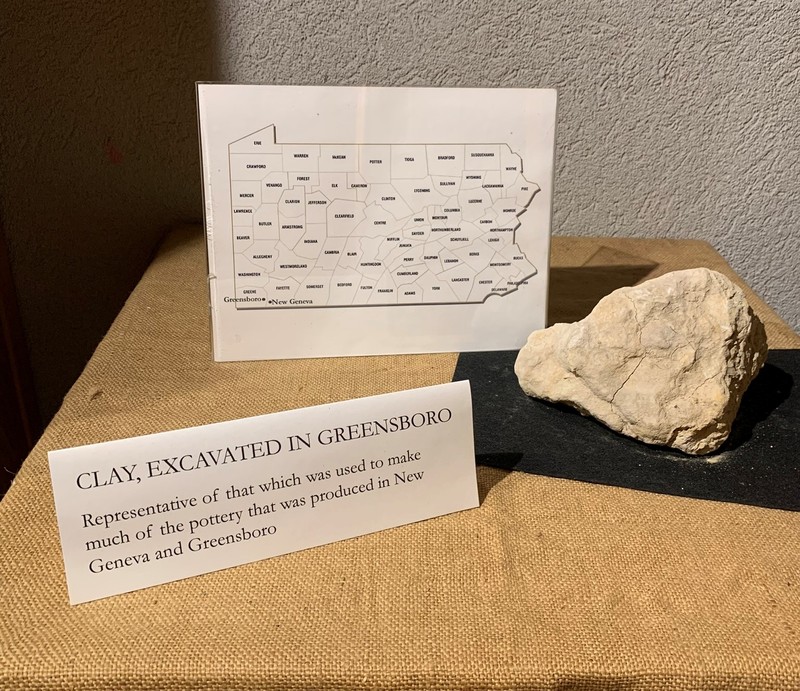
Greensboro Potters (exhibit sign)
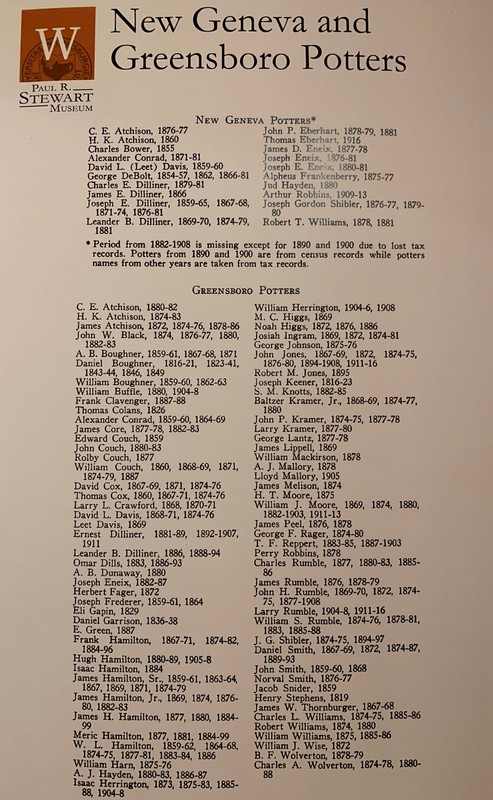
Stoneware mug produced by the Union Pottery Company in Point Marion, PA. The Union Pottery Company only operated between 1897 and the early 1900s and produced utilitarian pieces in one kiln. Because of its limited operation, Union Pottery Company pieces are rare to find.
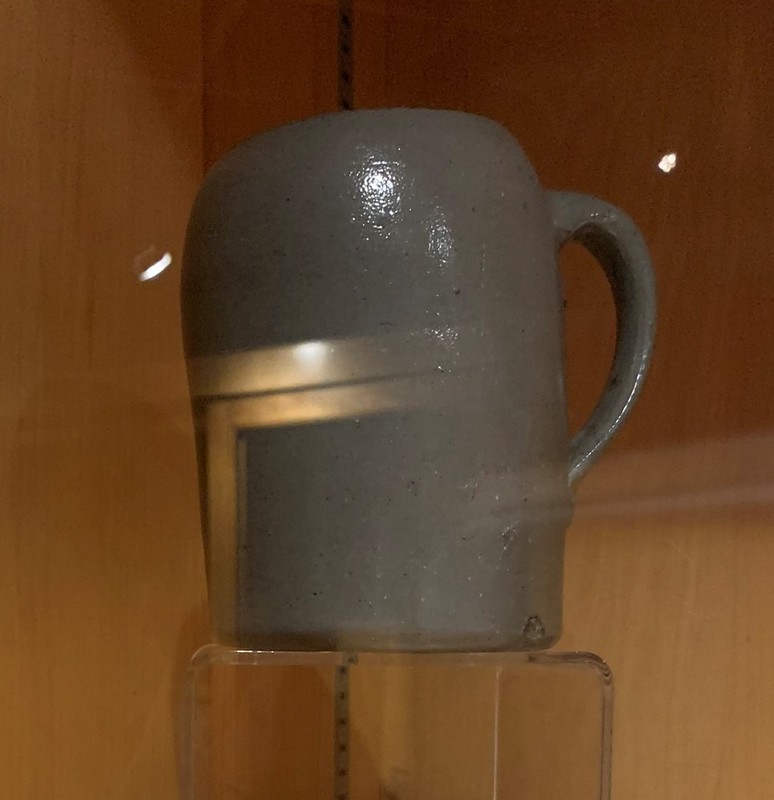
Bust of Greensboro resident Daniel E. Mercer, likely sculpted and then covered with Albany slip. Circa 1880-1900. On the 1880 Federal Census Daniel E. Mercer is listed as a 15-year-old working in a stoneware shop and he continued working in the pottery industry in Greensboro until sometime between 1890 and 1900 when he and his family moved to Parkersburg, WV.
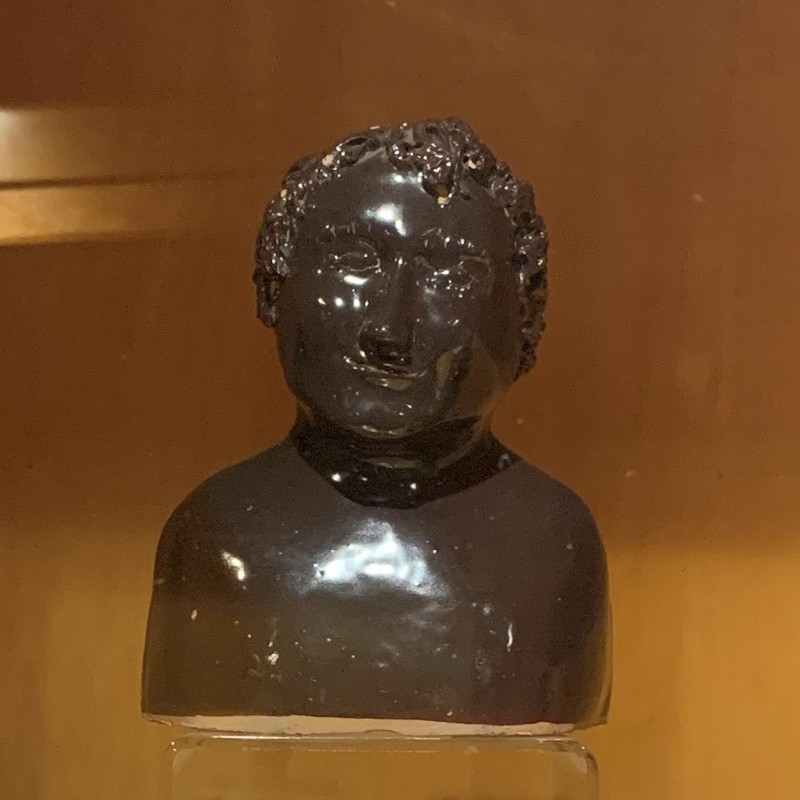
Stoneware Grease Lamp, c. 1860. Possibly produced by A. V. Boughner, Greensboro, PA. The body of the lamp was thrown on a wheel with the handle and spout attached by hand.
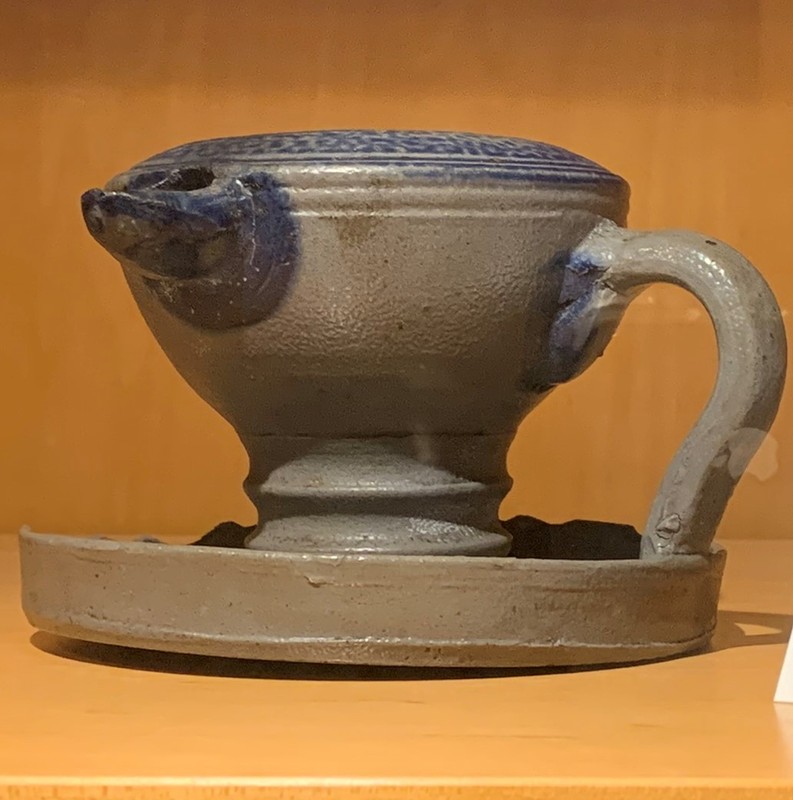
This doll head was press molded and hand painted around 1870. Molded or cast pieces were rare in the Greensboro—New Geneva pottery region.

Meat tenderizer, salt-glazed stoneware and hand painted with wooden handle, c. 1865.
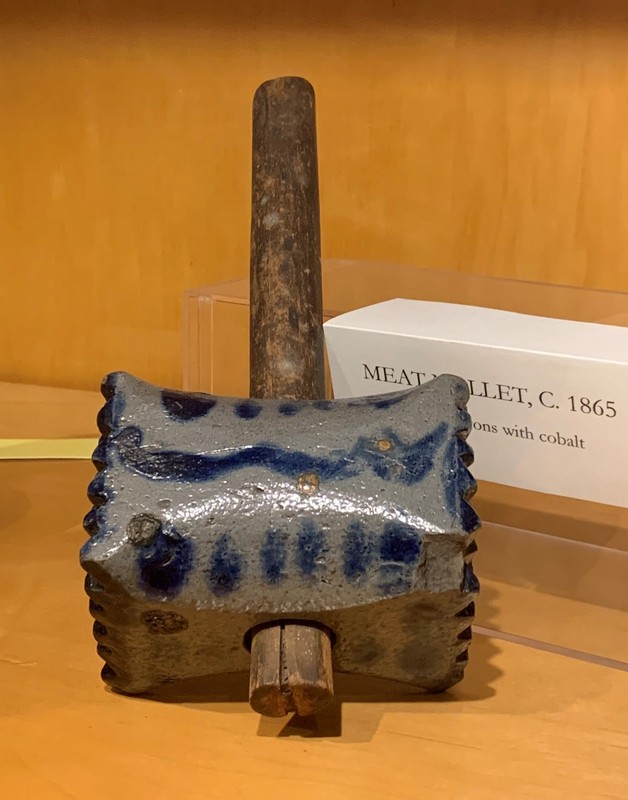
Tanware Flower Pot, New Geneva, PA. Many tanware pieces were produced to sell to riverboat tourists or as gifts, and pitchers and flowerpots were the most common pieces made.
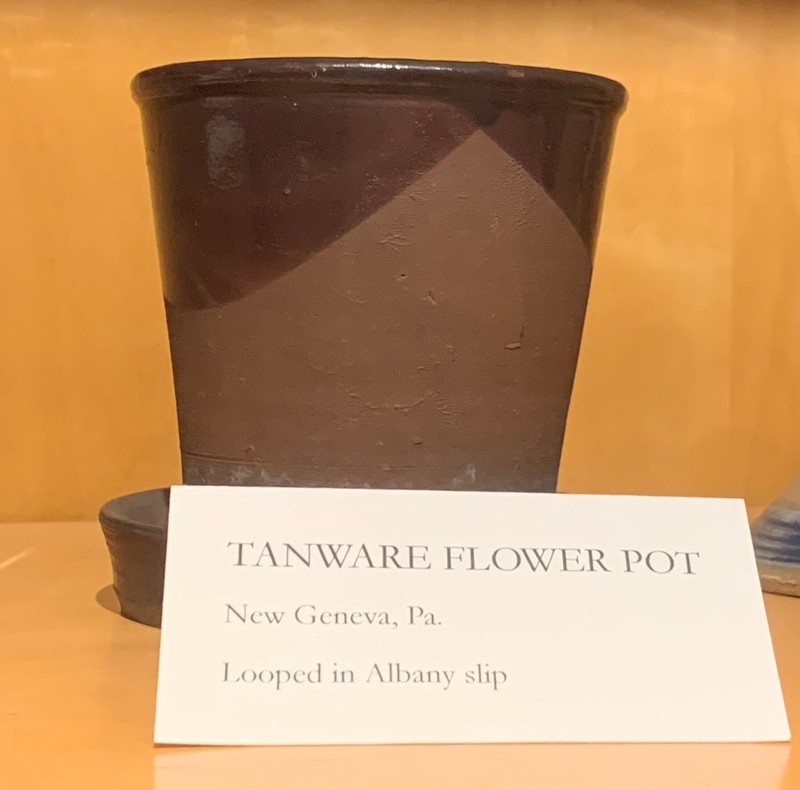
Stoneware bugle, made by Dan Templeton of Templeton's Salt Glazed Pottery in Wheeling, WV
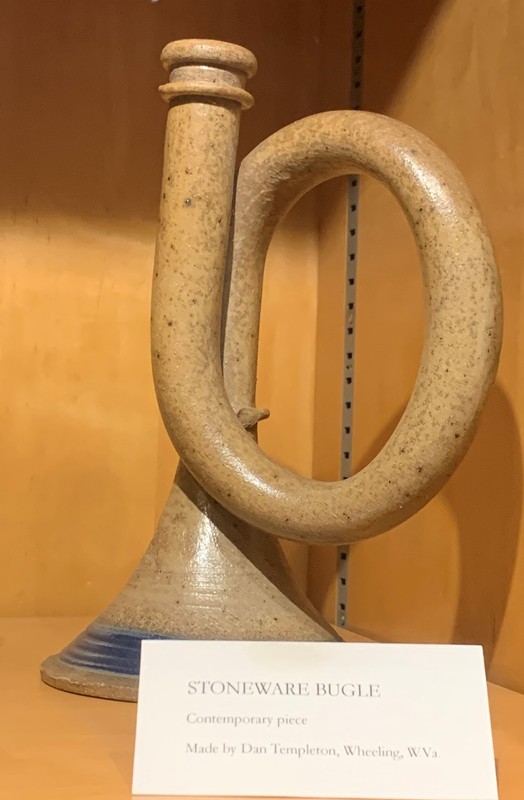
Molded cake pan or puddling mold, salt-glazed stoneware, hand painted and possibly made for a specific person, n.d.
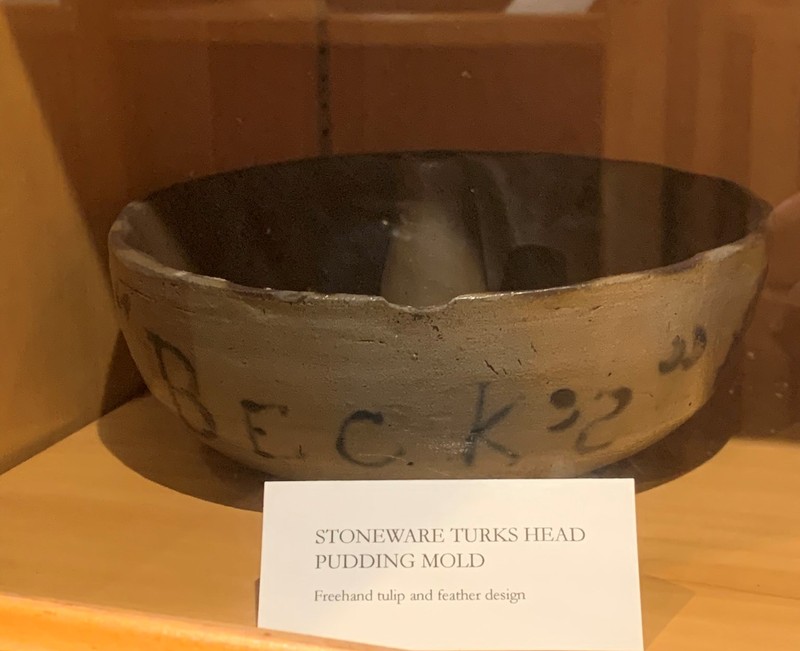
1860s stoneware flask, possibly made in Greensboro, PA
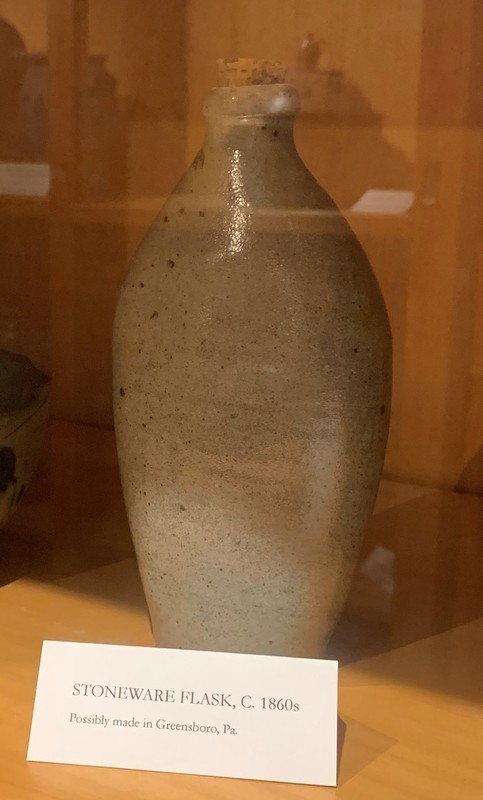
Salt-glazed stoneware with original lid and wax sealer, c. 1870. These canning jars were used to preserve fruit, vegetables, and other foods. Lids were sealed at the top with wax.
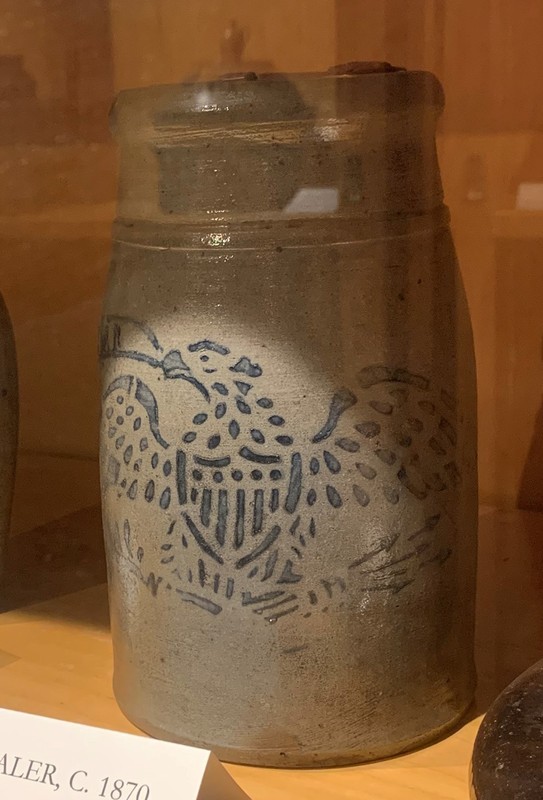
Whiskey decanter made by John Marietta, December 1836. Location undetermined, although there is a John Marietta listed for Weston, PA working in earthenware in the 1830s (US Craftperson Files, The Henry Francis du Pont Winterthur Museum, Ancestry.com).
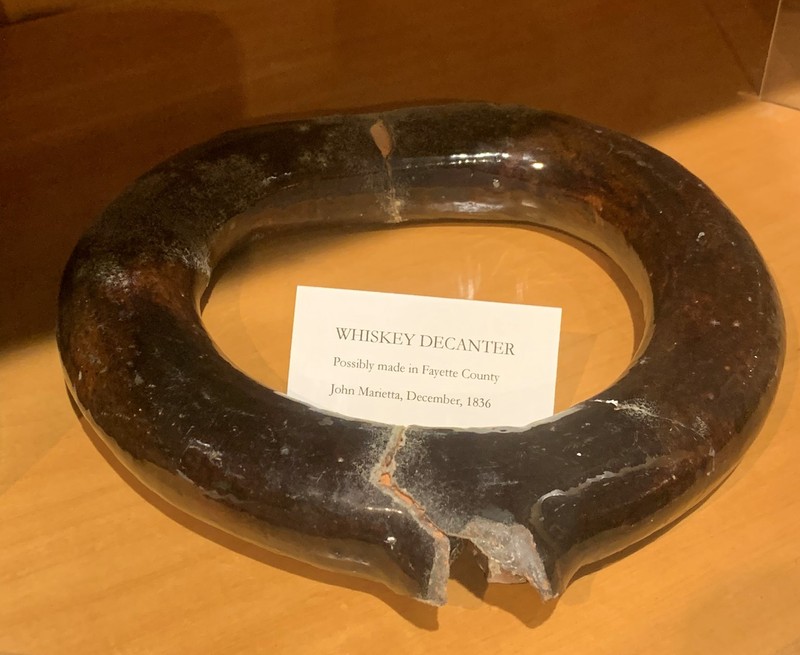
Miniature Pitcher, salesman’s sample. Made in Greensboro, PA.
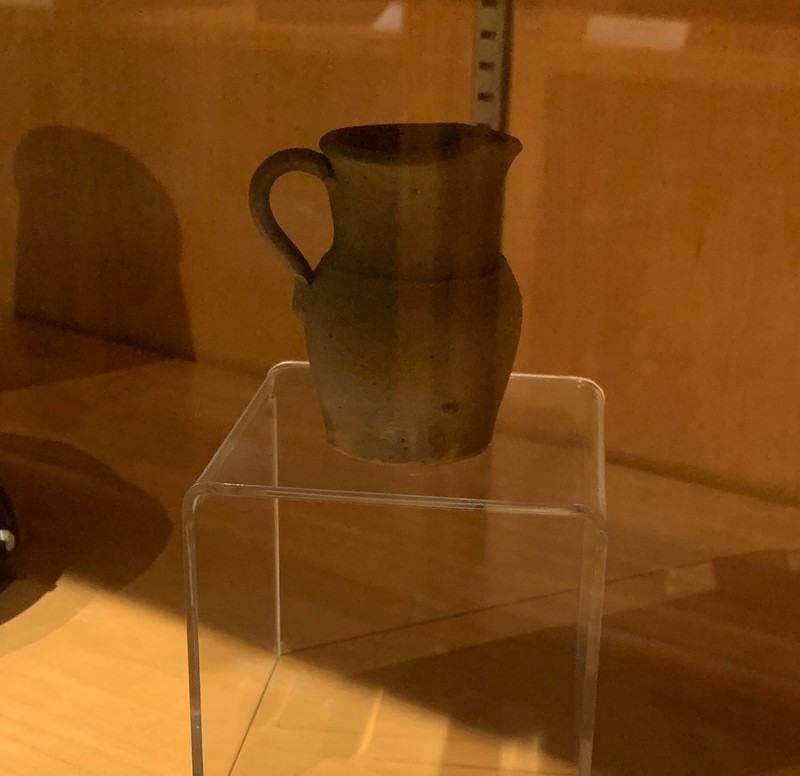
These two tiny jugs were thrown around 1880 during a contest to make the “World’s Smallest Pot.” The winning pot was made by Frank Cleavenger of Greensboro who specialized in large, 20-gallon jugs. The runner-up was made by Eliza Green. These tiny jugs are functional and can hold liquid, which was a requirement for the contest.
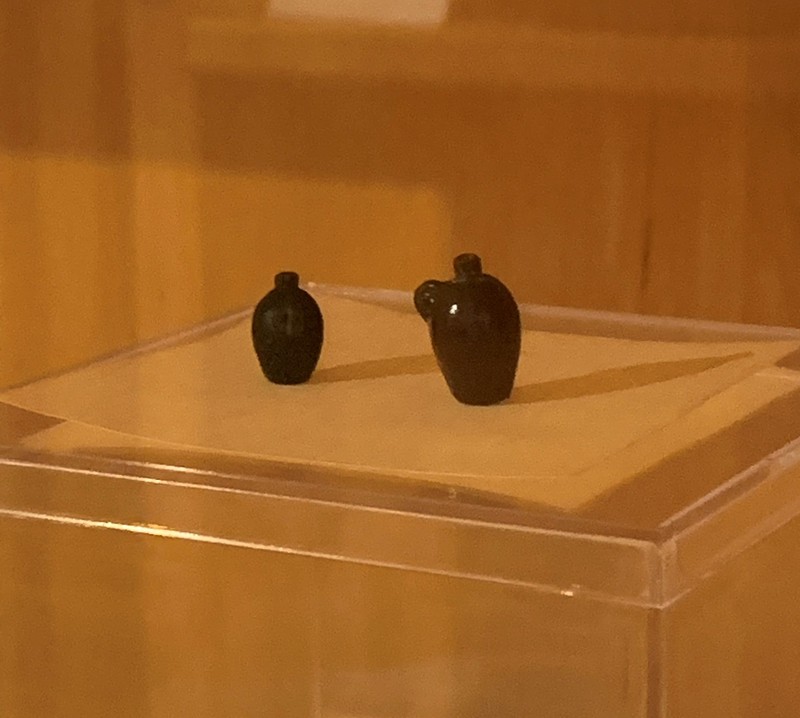
Miniature jug, salesman's sample, Greensboro, PA.
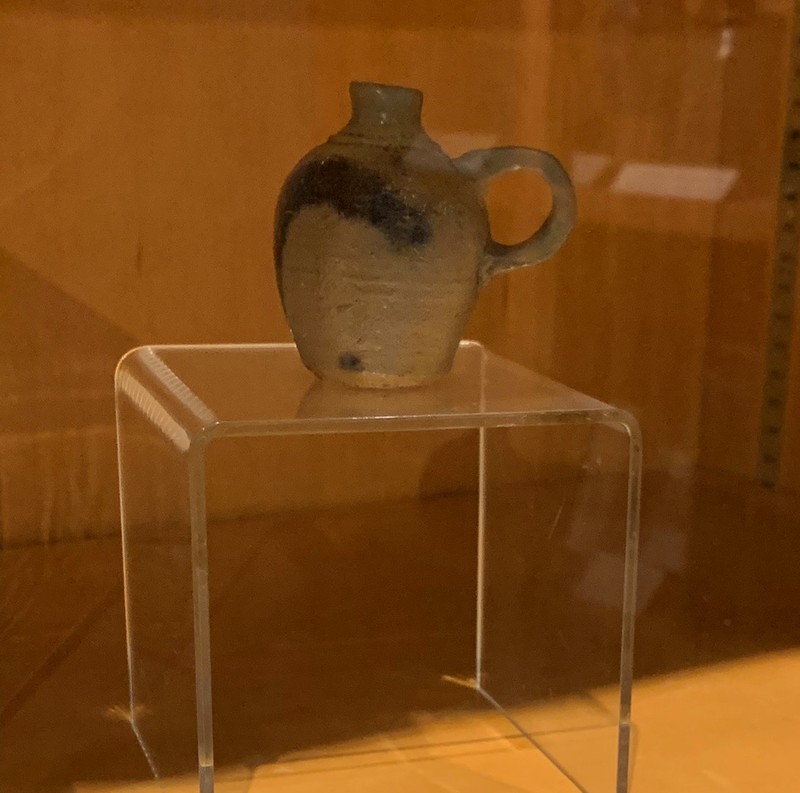
Miniature cuspidor, or spittoon, produced by Williams & Reppert, Greensboro, PA. Possibly meant to be a toy. This was dug up in a garden near the location of the Reppert & Williams factory. Spittoons were used in the mid-nineteenth century when tobacco chewing was popular—this was a pot for chewers to spit into. These ceramic spittoons were replaced in the late-nineteenth century by brass cuspidors and then spittoons in general became more obsolete as less people chewed tobacco and hygiene improved.
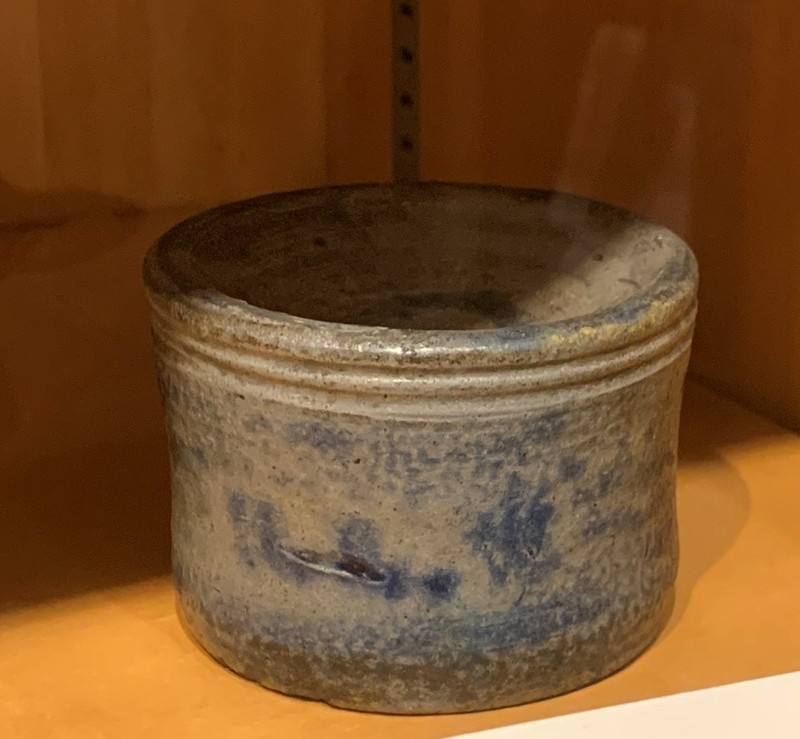
12-gallon jar produced by James Hamilton & Co around 1865, Greensboro, PA.
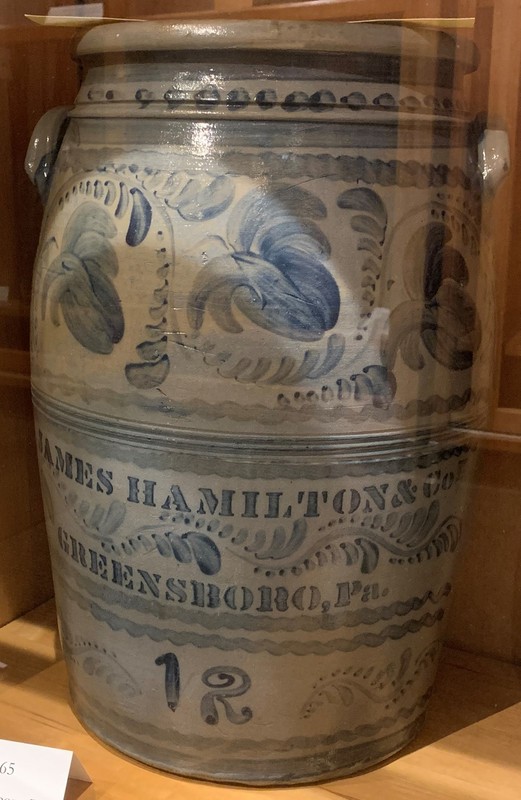
6-gallon jar produced in New Geneva, PA by C. L. Williams & Co around 1896.
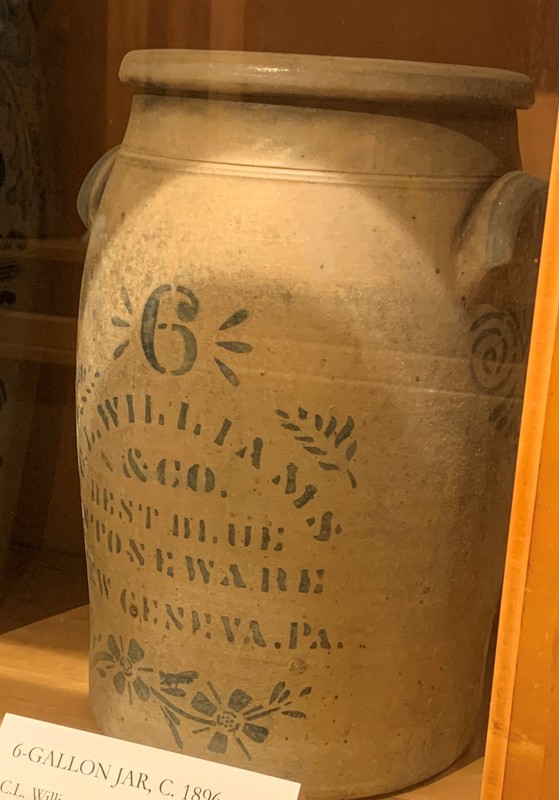
This 20-gallon jar was produced by the James Hamilton Co., also known as Eagle Pottery. It was made for W. D. Cooper and Bros., a wholesale grocer located at 7 Diamond Square in Pittsburgh, PA in the 1870s. The eagle design was popular on pottery, especially around the time of the nation’s centennial.
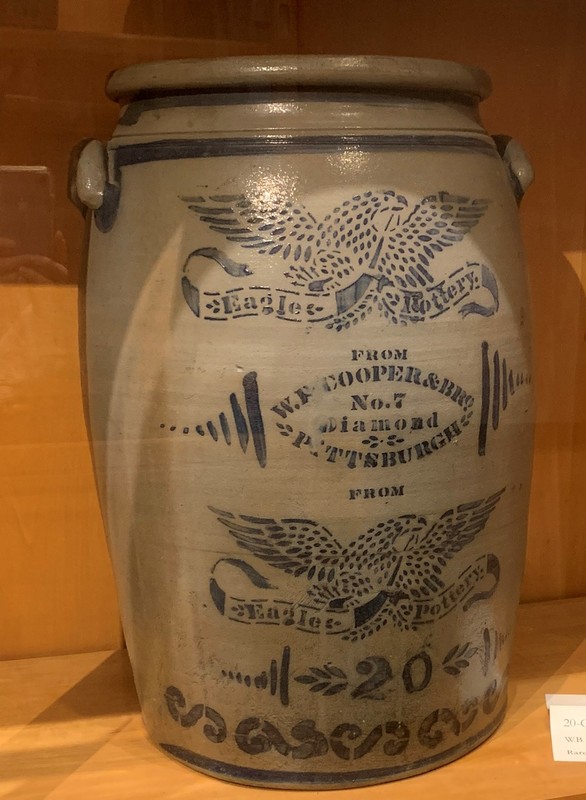
Tanware cake crock made in New Geneva, PA.
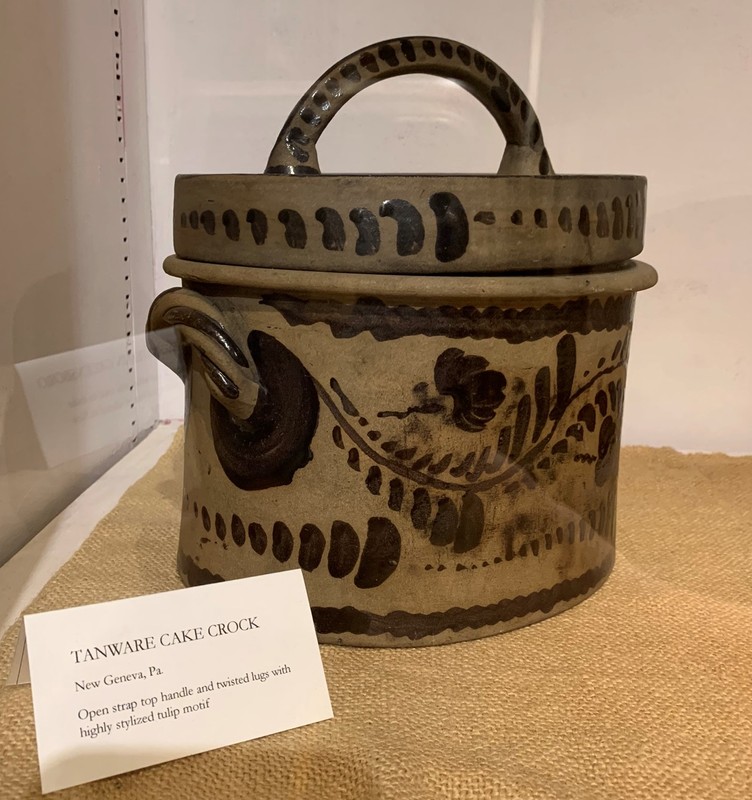
Redware coffee jar commissioned for Mary A. Core of Glassworks, PA (part of Greensboro). Possibly made by Hamilton & Jones in Greensboro, PA.
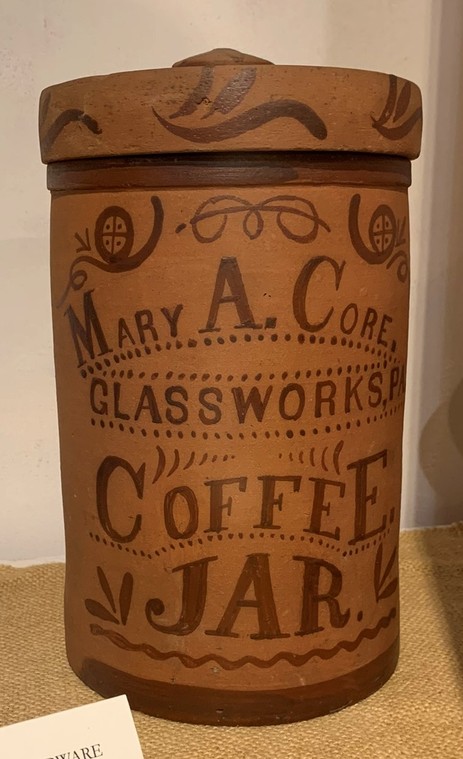
Three tanware pieces made in New Geneva, PA, likely late-nineteenth century. Two pitchers—one with hand-painted tulips and the other with a complete glaze. The third piece is a bank.
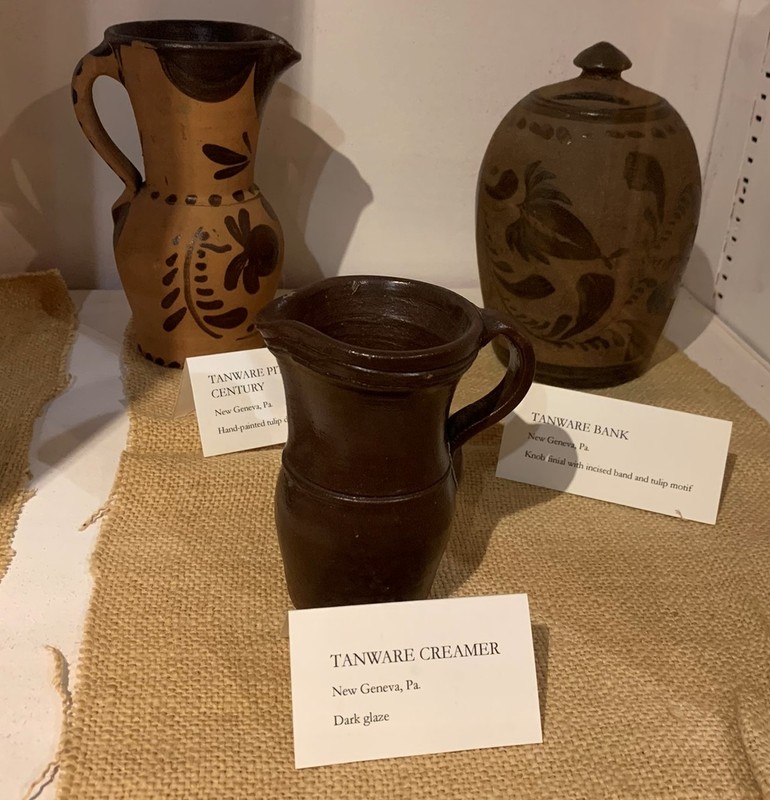
2-quart redware jug, circa 1810, with lead glaze. Attributed to Alexander and James Vance, the first documented potters in Greensboro.
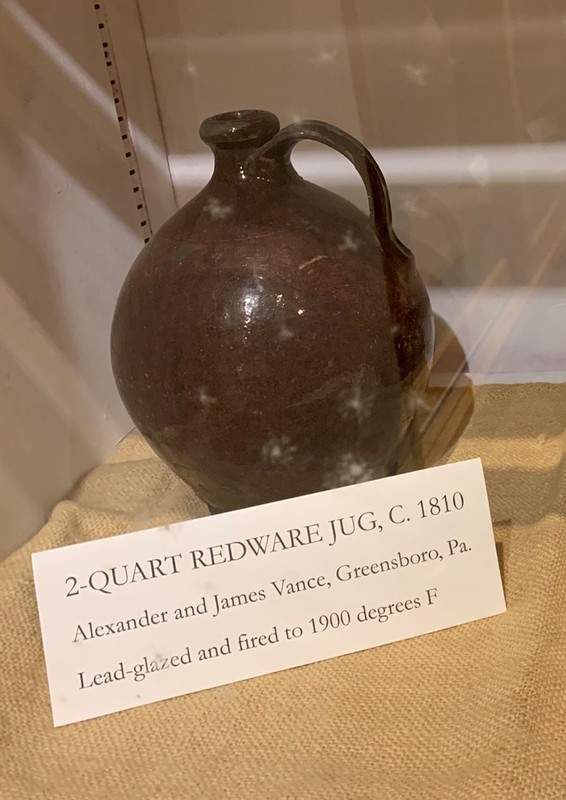
Tanware pitcher, likely a gift pitcher due to the more ornate hand-painted decoration. Found in the Greensboro region, c. 1880.
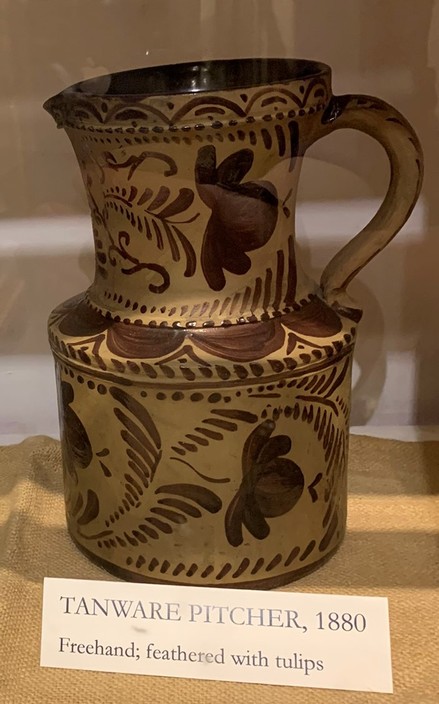
Staffordshire dog, circa 1892. This is an example of one of the few cast or molded pieces produced in the Greensboro area. It is glazed with Albany slip. These were intended to be decorative and were often used as doorstops.
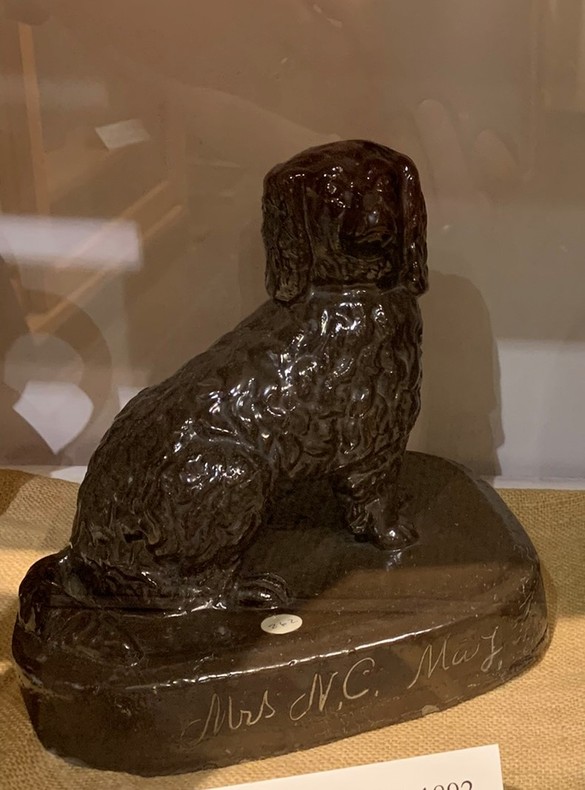
Redware chicken drinking foundation, produced in New Geneva around 1890. Chicken fountains typically had a spout on the side or were paired with a bowl that sat underneath for the chickens to drink water from.
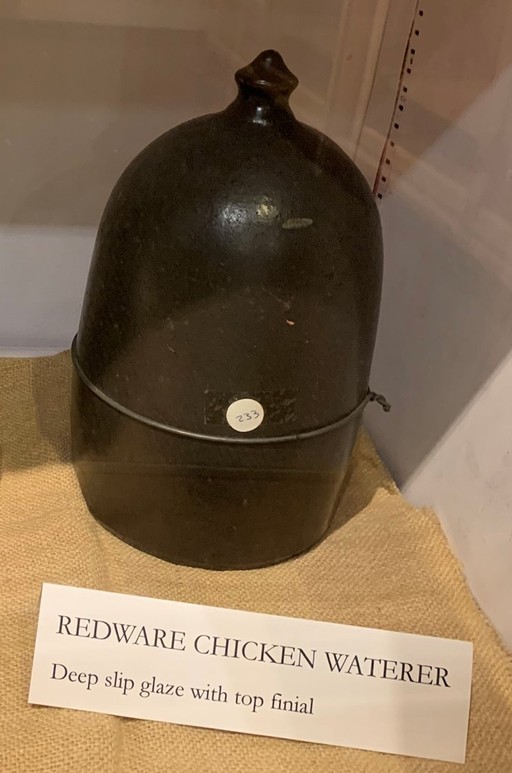
2-quart jar made in the 1860s. Greensboro area pottery did not typically include decorations featuring human shapes. Pieces like this were often created for special occasions, such as birthday or anniversaries, and sometimes also featured animals or birds. These “peoplecrocks” were typically produced in Uniontown, Connellsville, or Morgantown, WV. At the time there was no significant market for these pieces and there was less attention paid to the decoration details; however, today these pieces are rare and valuable.
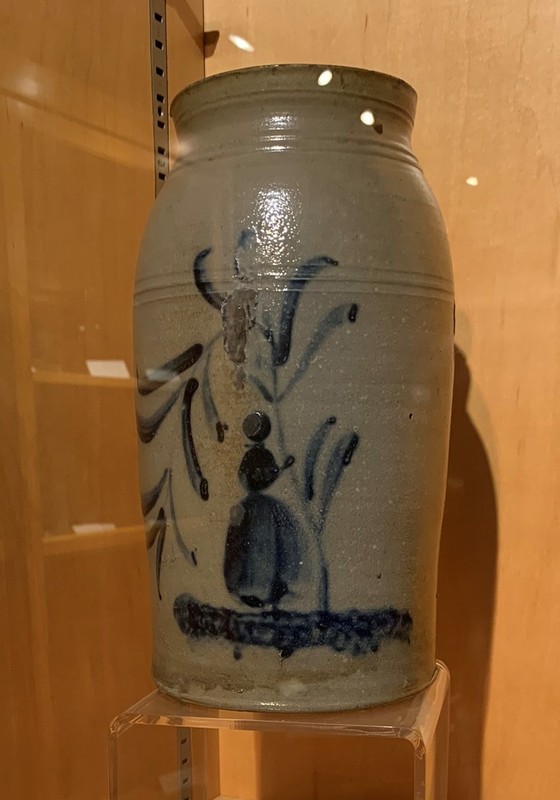
1-gallon jar, produced by Williams & Reppert of Greensboro, PA around 1880-1890. Donated by Rev. R. Edson ’60 and Sally Reed.
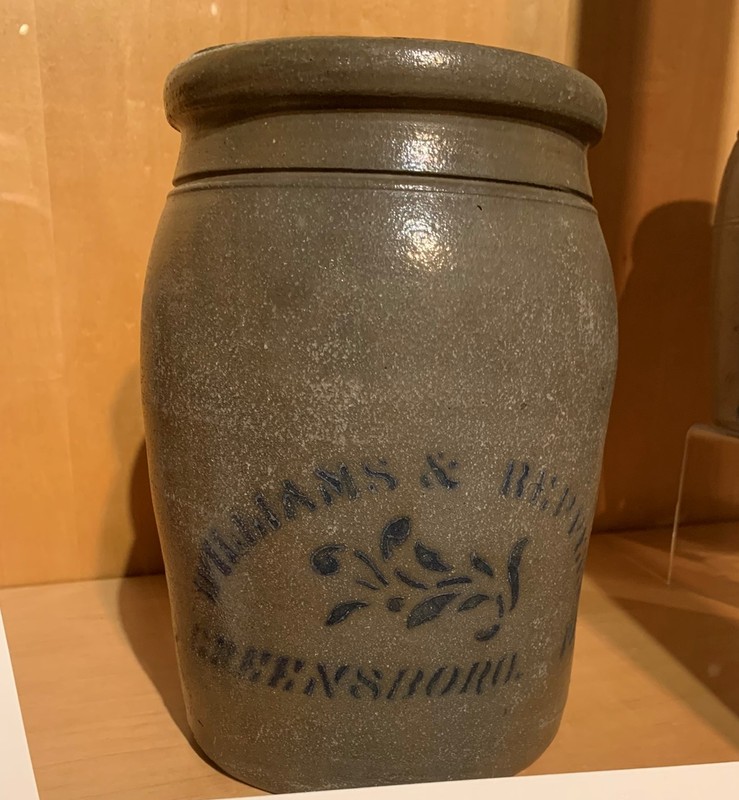
½-gallon canning jar produced by Hamilton & Jones in Greensboro, PA.
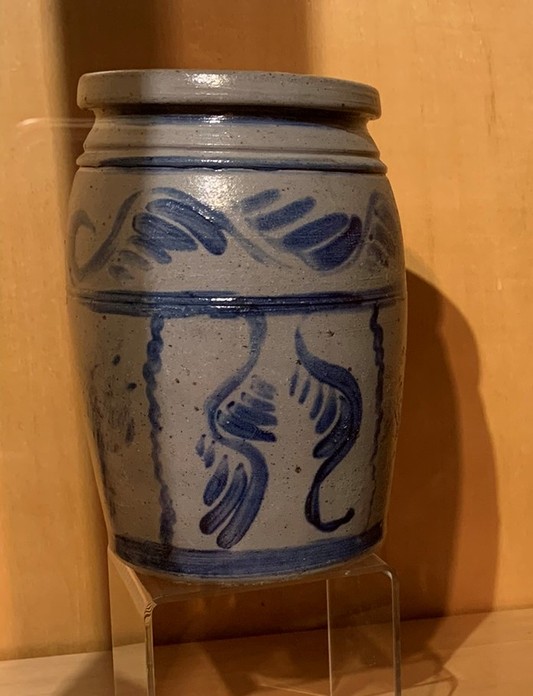
1-gallon bean crock produced by John P. Eberhart & Co. in New Geneva, PA.
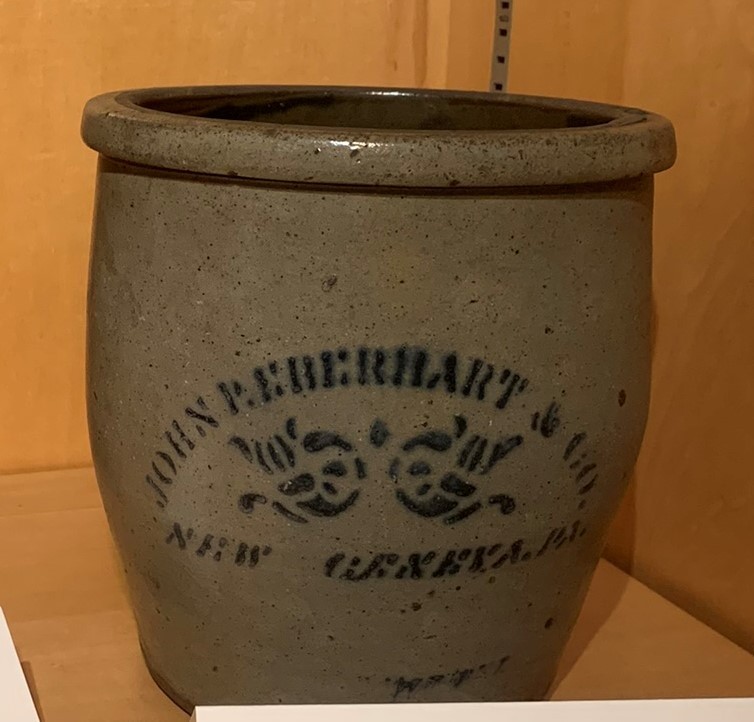
Large crock produced by A. & W. Boughner to honor Reverend John McClintock. McClintock was born in Washington, PA and apprenticed as a weaver before attending Washington College. He then entered Western Theological Seminary at Allegheny, PA and finished his studies in 1837. In July 1839 McClintock became the pastor of the New Providence Presbyterian Church in Cumberland Township and served that congregation for 50 years. He died in 1891.
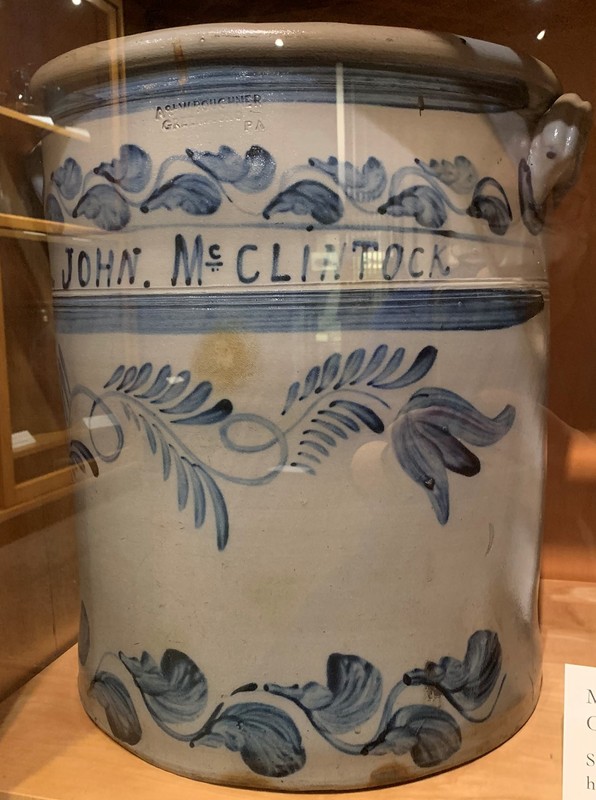
Photograph of Rev. John McClintock and image of his residence from a larger work
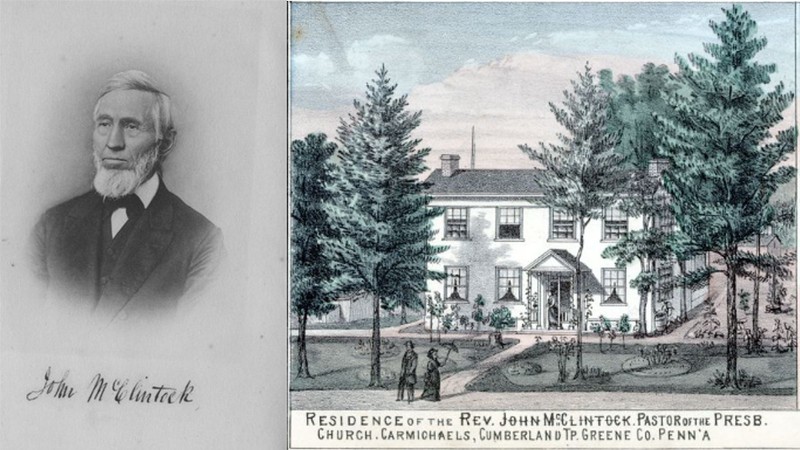
3-gallon crock produced by C. L. Williams & Co, New Geneva, PA.
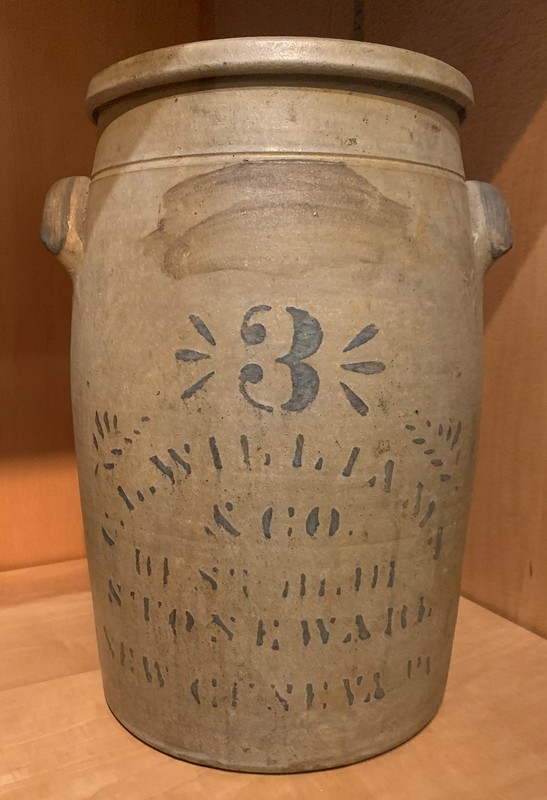
5-gallon jar produced by James Hamilton & Co, Greensboro. PA.
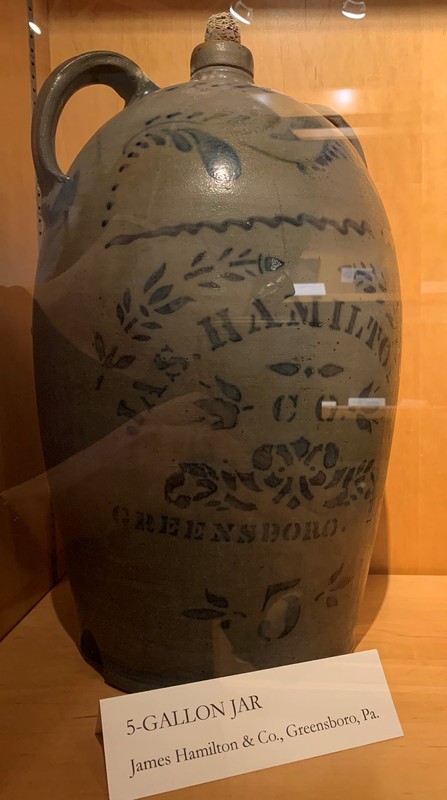
5-gallon jug produced by James Hamilton & Co, Greensboro. PA.
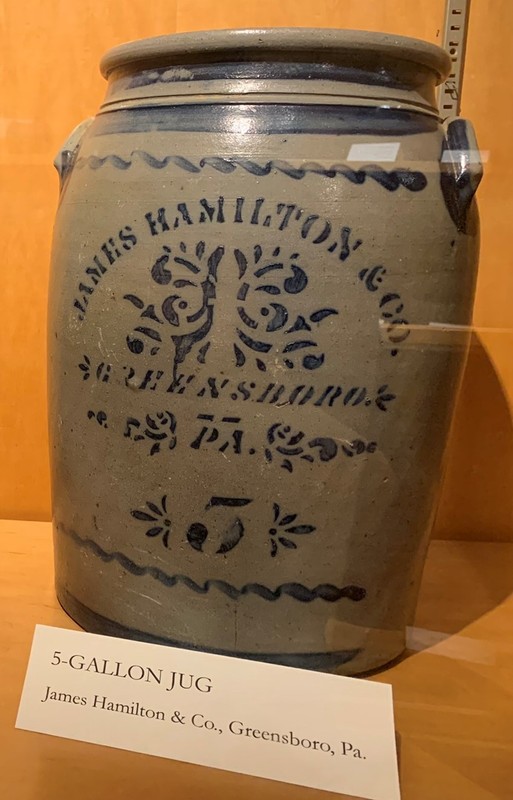
6-gallon jar produced by Daniel Boughner, Greensboro, PA, 1847.
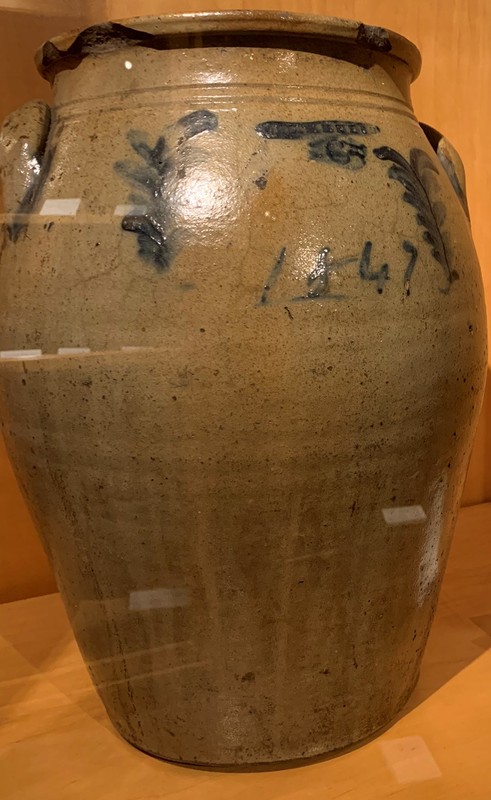
15-gallon jar produced in 1867 by Hamilton & Jones under the company name “Union Works,” Greensboro, PA. It is possible that this jar was made around the time of the marriage of John Jones to the daughter of William L. Hamilton, with the unusual spelling of “Joness” signifying the union of the two families.
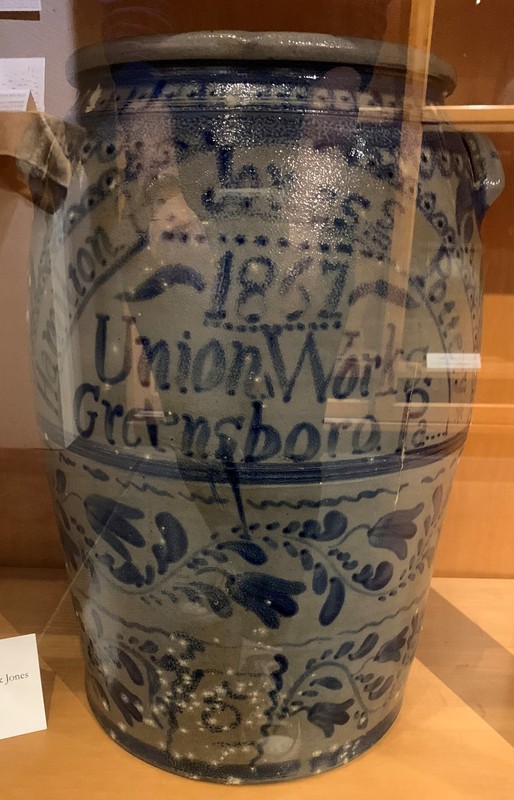
Cake crock made for C. Baker, salt-glazed stoneware, hand painted with miniature jug for handle, n.d. Attributed to Eniex and Frankberry, New Geneva, PA.
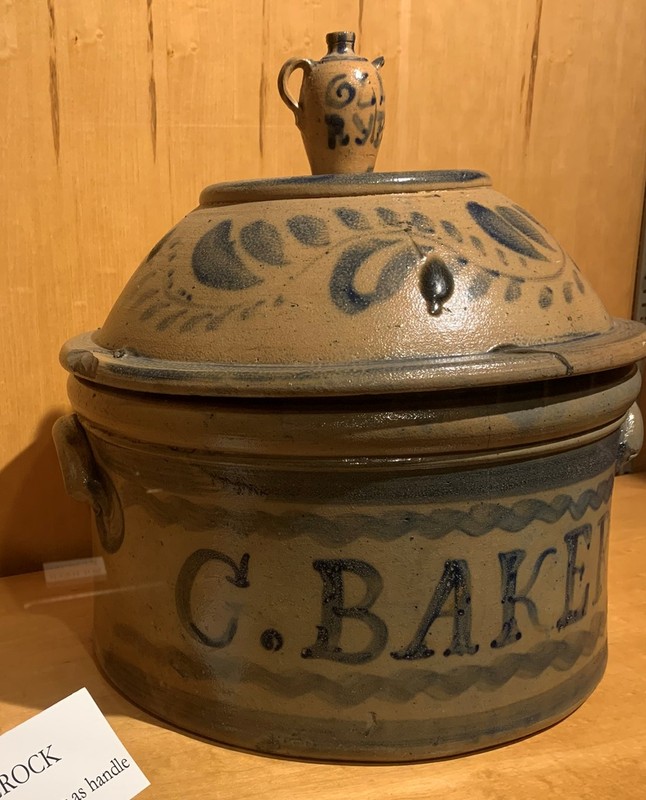
3-gallon jar, produced by A & W Boughner, circa 1855. A. V. and William Boughner were the sons of Daniel Boughner, and took over the pottery business from their father.
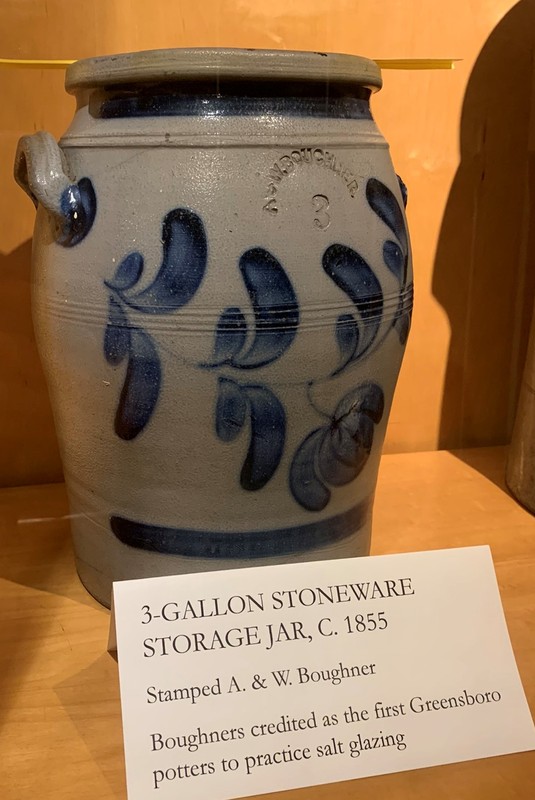
6-gallon butter churn, circa 1860, likely produced by Boughner in Greensboro, PA. The rim of the churn may have been damaged during firing.
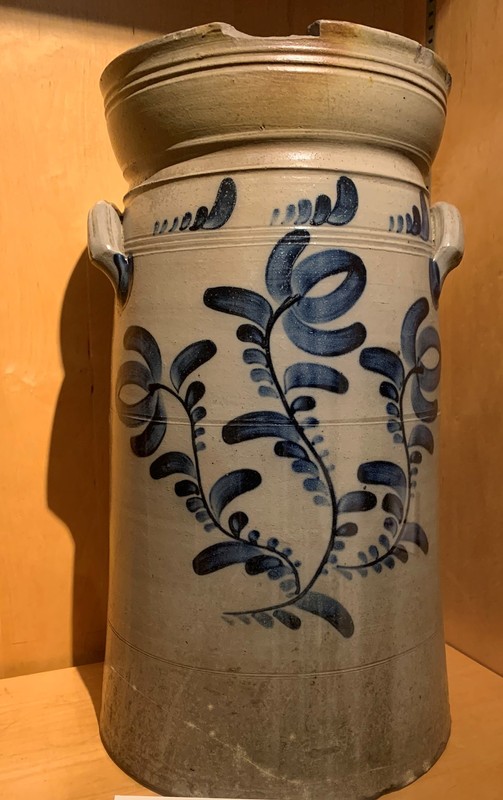
12-gallon jar with freehand star design, produced by A. V. Boughner, Greensboro, PA.
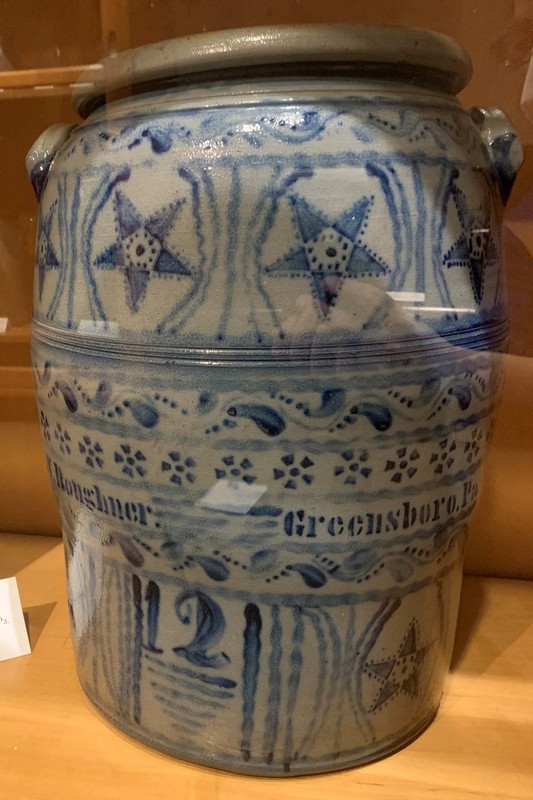
10-gallon jar, produced by James Hamilton & Co, Greensboro, PA, 1852.
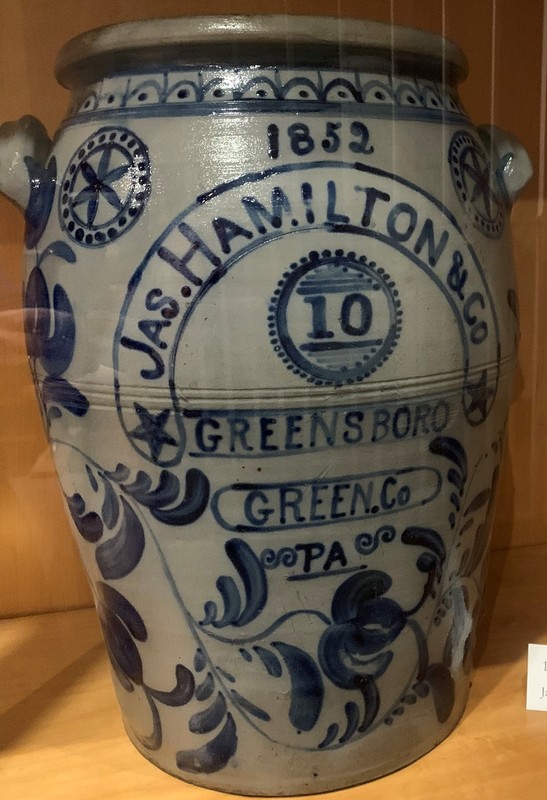
Backstory and Context
Text-to-speech Audio
How was Greensboro-New Geneva Stoneware Made:
The clay used for stoneware was known as a “high terrace clay” that was described as a “stiff white clay.” This type of clay contained feldspar, which helped the clay harden into a non-porous stoneware, and silica, which was needed for salt-glazing.
Clay was pit mined from the banks of the Monongahela River by teams of men who would then load the clay onto wagons for teamsters to deliver to area potteries. Potteries stockpiled clay until they were ready to use it. To prepare the clay, workers used a pug mill to grind the natural clay into smaller particles. This was often done on a horse-powered mill where a horse walking in a circle turned the mill shaft that first ground the clay and Mthen added water and sand to achieve the desired consistency. Any final impurities were screened out of the clay and then apprentices kneaded the clay and separated it into round balls for the potters to use.
Most stoneware pieces were thrown on a wheel by a master potter. Handles and other smaller pieces were typically pulled or molded by hand and attached to the piece using a wet clay called slip. A few, rare pieces were produced by molding or casting. Smaller pieces could be made in one piece, but larger crocks and jars were made in 2-3 sections and joined together. Once the ware was complete it was then air-dried.
Decoration was completed during the drying process before the pieces were placed in the kiln for firing. The most common decoration used in Greensboro-New Geneva stoneware was painting. This was done with a stenciled design or hand painting and was typically blue. Early pieces did not have the manufacturer’s name in the design, but later companies often stenciled their names on their pieces.
Cobalt blue oxide was used to create the blue paints used on Greensboro-New Geneva ceramics. The cobalt blue was used because it was the metallic oxide that could best withstand the high temperatures needed in the firing process. Other paints and oxides would simply burn off in the kiln, although occasionally an iron oxide was used which created a brown or Black decoration.
To produce the cobalt blue glaze, cobalt ores were first roasted to produce an impure cobalt oxide called “zaffre.” This was then combined with sand or flux to create a mixture named “smalt.” This mixture was then ground and mixed with water to produce the cobalt-blue glaze that could be painted onto the ceramic.
Some other forms of decoration included imprinting (using a pointed stick or cut design mold to press a design into the clay before it was dried) or dipping the piece into a layer of slip and then scraping away parts to create a design.
Once the ware pieces were dried and decorated, they were packed into kilns for firing. Kilns used in the Greensboro-New Geneva industry were typically large, bottle-shaped, updraft kilns. Some of these kilns were upwards of 40 feet tall and could hold thousands of ceramic pieces in one firing, representing weeks of work.
Pieces such as jars and crocks were stacked mouth to mouth or foot to foot on top of each other. Other pieces, such as jugs that had handles, were more difficult and separators called collars were used to keep these pieces level in the kiln. Stilts and hand-molded lengths of clay called spurs were also used to keep pieces separated.
The firing process took 48-72 hours. For the first 6-8 hours, the temperature was kept low (no higher than 200-250 degrees Fahrenheit). This “soaking” temperature ensured that all the pieces were completely dry. After the 8-10 hour mark the kilnman increased the heat up to the desired 2200-2300 degrees. At that temperature the clay underwent a thermochemical reaction that partially liquified and crystallized the material, allowing it to then solidify into the hardened stoneware as it cooled. At that peak temperature the clay was also ready for salt-glazing.
Salt-glazing originated in Germany in the 15th century. Other types of glazes are done after the firing process and adds a thin layer of glass or glass and crystal that creates a hard, non-absorbent, easy to clean surface to pottery. Salt-glazing is different because it is done during the firing process, which eliminates extra steps and makes the process faster and more efficient. Salt-glazing is also incorporated into the actual body of the clay piece, which reduces chips and damage.
As the kiln reached the necessary temperature, the silica present in the clay was reactive. At that point, workers standing on scaffolds on the outside of the kiln threw shovels of salt into holes in the sides of the kiln. In the high heat, the salt instantly vaporized and then reacted with the silica in the clay and water vapor in the air (which supplied the oxygen necessary for the reaction) to produce a glaze on the ceramic. As kilns were used, salt built up on the interior and workers had to add less salt to produce the desired glaze.
The salt-glaze only settled on the exterior of the pieces, so an additional glaze was used for the interior. The most common interior glaze was a layer of Albany slip which was added prior to the firing process. Albany slip was made from clay mined in Albany, New York that was high in iron and other impurities and had a low fusing point. Albany slip was cheap, reliable, and easy to use, and was common for both interior and exterior glazing.
Once the firing was complete, the kiln would cool for 1-2 days before the pottery could be unloaded, inspected, and readied for sale or shipping.
Redware, Stoneware, and Tanware
Southwestern Pennsylvania potters manufactured both redware and stoneware. Redware was more common and made from the same clay as bricks. Redware needed a glaze to make a piece non-absorbent to hold food and liquids.
Stoneware was made from a denser clay and could be fired at higher temperatures. As a result, the pieces were harder and less porous. Stoneware did not need a glaze to be used as storage. This was more desirable, but less available because the necessary clay was only found in limited locations. Stoneware could be produced in larger sizes, and as a result the Greensboro-New Geneva industry became known for producing large jars and crocks which required skilled potters to manufacture.
Tanware was created by using Albany slip clay (used to coat the interior of pottery) as the decoration on the exterior of the pottery instead of the signature blue. Tanware was also placed in saggers during the firing process to keep the pieces away from the salt vapors in the kiln. This prevented the chemical reaction occurring and resulted in a matte tan surface instead of the shiny glaze of salt-glazed stoneware.
Greensboro
The first documented date for Greensboro area pottery was 1806 when Alexander Vance purchased a lot in Greensboro. Alexander and James Vance moved to Greensboro from New Jersey around 1800 and produced redware. In 1805, the Vance brothers took in orphan Daniel Boughner and trained him. Boughner married Mary Vance in 1811 and when the Vance brothers moved to Ohio in 1819 Boughner bought and continued the Greensboro pottery business. He made both redware and stoneware and is credited for producing the first Greensboro stoneware before the 1850s. In 1864, the Boughner pottery was sold to his son A. V. Boughner and continued operating until 1868.
The other major pottery company in Greensboro was the Hamilton company. William Leet Hamilton and James Hamilton arrived in Greensboro around 1850 and each established a separate pottery. The William Leet Hamilton firm was sold to his son Frank Hamilton and John Johns, but this firm closed after a large fire destroyed the property in 1897. James Hamilton’s company was eventually co-owned by Larry L. Crawford, Thomas F. Reppert, and W. T. Williams. The firm was still operating as Reppert and Williams around 1920 when the industry declined.
New Geneva
The earliest potters in New Geneva were Henry K. Atchison, George DeBolt, and S. R. Dilliner, and sources disagree on who was the first to produce pottery in New Geneva. While these potters operated around 1850, the New Geneva pottery industry began later than that in Greensboro and was not competitive until the 1870s.
In 1872 Alexander Conrad established a pottery in New Geneva which operated for a decade before it was sold to Charles W. Williams. Williams’ heirs sold the company to Robert T. Williams in 1889.
The second main pottery in New Geneva was founded by Leander B. Dilliner in 1873. For a few years this company was owned by the Eberharts—John P., Thomas P., and Adolph A. Eberhart at different times—and then it was also bought by Charles W. Williams. After Williams’ death the pottery was briefly owned by D. D. Sandusky and then sold to Robert T. Williams in 1890.
After 1890 Robert T. Williams controlled the pottery industry in New Geneva. In 1896 the Williams pottery was sold to Charles L. Williams, Arthur Robbins, Margaret Hamilton, and Isaac Herrington, during which many of the produced pieces are marked C. L. Williams. Arthur Robbins eventually acquired sole rights to the company and operated it until his death in 1915. This marked the end of the pottery industry in New Geneva.
A third New Geneva pottery was established in Springhill Township by James D. Eneix on land owned by Joseph E. and Leander B. Dilliner. Alpheus Frankenberry joined the business as Eneix’s partners between 1876 and 1878 during which pottery was produced with the label Eneix and Frankenberry. In 1879, Leander B. Dilliner sold his portion of the business to William Evans and the company then was known as Eneix and Evans.
Sources
Archeological Investigation of the New Geneva Pottery Waster/Dock Site (36FA404). Cultural Resources Management. US Army Corps of Engineers, Pittsburgh District. January 1995. Waynesburg University.
Bates, Samuel P. History of Greene County, Pennsylvania. Chicago: Nelson, Rishforth &Co., 1888.
“Greensboro/New Geneva Multiple Property Submission.” National Register of Historic Places. Accessed March 9, 2022. https://npgallery.nps.gov/GetAsset/0e213e6d-3e52-4564-9635-8be3c280e3b5.
Guappone, Carmen A. New Geneva & Greensboro Pottery: Illustrated and Priced. McClellandtown, PA: Guappones’ Publishers, 1975. Waynesburg University.
Kilgore, Clay. “Walk to Remember.” Observer Reporter. April 12, 2018. Accessed March 16, 2022. https://observer-reporter.com/news/looking_back/walk-to-remember/article_13c52606-ea17-5050-90ce-c50a440edf23.html.
Michael, Ronald L., and Phil R. Jack. “The Stoneware Potteries of New Geneva and Greensboro, Pennsylvania. West Pennsylvania History: 1918-2018 The Western Pennsylvania Historical Magazine, 56, 4 (October 1973): 363-382.
Michael, Ronald L. “Stoneware from Fayette, Greene, and Washington Counties, Pennsylvania.” Northeast Historical Archaeology 6, 6, Article 5 (1977): 33-41.
“Rev John McClintock.” Find A Grave. Accessed March 21, 2022. https://www.findagrave.com/memorial/108768022/john-mcclintock.
Schaltenbrand, Phil. Old Pots: Salt-Glazed Stoneware of the Greensboro-New Geneva Region. Hanover, PA: Everybodys Press, 1977.
Swala, Frank, and Susan Swala. “Tanware.” Resource Library. Westmoreland Museum of American Art. June 28, 2007. Accessed March 16, 2022. http://www.tfaoi.com/aa/7aa/7aa783.htm.
Photograph by Kathleen Thompson
Photograph by Kathleen Thompson
Photograph by Kathleen Thompson.
Photograph by Kathleen Thompson.
Photograph by Kathleen Thompson.
Photograph by Kathleen Thompson.
Photograph by Kathleen Thompson.
Photograph by Kathleen Thompson
Photograph by Kathleen Thompson
Photograph by Kathleen Thompson
Photograph by Kathleen Thompson
Photograph by Kathleen Thompson
Photograph by Kathleen Thompson
Photograph by Kathleen Thompson
Photograph by Kathleen Thompson
Photograph by Kathleen Thompson
Photograph by Kathleen Thompson
Photograph by Kathleen Thompson
Photograph by Kathleen Thompson
Photograph by Kathleen Thompson
Photograph by Kathleen Thompson
Photograph by Kathleen Thompson
Photograph by Kathleen Thompson
Photograph by Kathleen Thompson
Photograph by Kathleen Thompson
Photograph by Kathleen Thompson
Photograph by Kathleen Thompson
Photograph by Kathleen Thompson
Photograph by Kathleen Thompson
Photograph by Kathleen Thompson
Photograph by Kathleen Thompson
Photograph by Kathleen Thompson
“Rev John McClintock.” Find A Grave. Accessed March 21, 2022. https://www.findagrave.com/memorial/108768022/john-mcclintock; "Ragan and Axell, Rev. John McClintock, A.I. Strosnider." Historic Map Works. Accessed March 21, 2022. http://www.historicmapworks.com/Map/US/73152/Ragan+and+Axtell++Rev++John+McClintock++A+I++Strosnider/.
Photograph by Kathleen Thompson
Photograph by Kathleen Thompson
Photograph by Kathleen Thompson
Photograph by Kathleen Thompson
Photograph by Kathleen Thompson
Photograph by Kathleen Thompson
Photograph by Kathleen Thompson
Photograph by Kathleen Thompson
Photograph by Kathleen Thompson
Photograph by Kathleen Thompson
